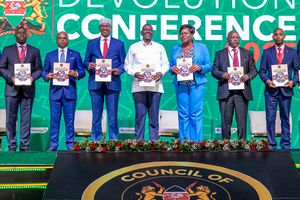Premium
Goat plague ruining herders’ livelihoods

Girls herd goats and sheep in Kirisia forest, Samburu West District. Goat plague, which was detected in Turkana District in 2006, has a devastating effect on food security in the arid areas. Photo PAUL LETIWA
The Ministry of Livestock Development has stepped up its fight against the dreaded goat plague (peste des petits ruminants or PPR) that is killing thousands of animals in most arid areas in the country.
The Nation has learnt that a Cabinet meeting was called recently to discuss ways of containing the plague and to source emergency funds.
The meeting also discussed the impact of the disease on the livelihoods of the vulnerable groups in the North Rift and north eastern Kenya. The issue of food security in the affected regions was also tabled.
In addition, the Cabinet highlighted the proposed necessary measures to contain the spread and eradicate the disease to safeguard the livelihoods and arrest the associated food insecurity.
According to Livestock Development permanent secretary Patrick Khaemba, about 23 million sheep and goats valued at Sh16.1 billion were likely to die of the disease. More than 58 per cent of the animals are in the Arid and Semi-Arid Lands (Asal), which are most susceptible to the plague.
Mr Khaemba said that about 10 million people depended on the animals for their livelihood. The animals were the source of meat, milk, blood and income.
Main casualties
The PS said more than 16 districts in the Asal zones had been hit by the plague with Samburu West, Samburu East, Pokot, Marakwet, Baringo and Keiyo districts being the most affected.
“Poverty levels in the Asal areas are high and poor households more often than not own only a few sheep and goats and no cattle. From the foregoing, it is evident that adverse situations such as outbreaks of sheep and goat diseases normally have devastating impacts on food security,” he said.
Speaking during the handing over of the Kenya Veterinary Vaccine Production Institute (KEVEVAPI) by the Ministry of Agriculture to the Livestock Ministry recently, Mr Khaemba said that the country did not have a vaccine to contain the disease, which was detected in Turkana District in 2006.
The PS said that the institute would be used to develop affordable vaccine against the disease.
But most farmers feel that the cost of combating the disease was too high. Nominated MP Maison Leshoono said that at least 50,000 sheep and goats had died in the larger Samburu district in the past six months.
She said food security in the district was threatened, adding that the school drop-out rate had risen as many parents could not afford school fees for their children.
The legislator regretted that a single family had lost more than 700 sheep to the plague.
“Why should animal vaccines be imported whereas KEVEVAPI was established to manufacture them?” posed Ms Leshoono.
The country has had to import the vaccine after the goat and sheep disease spread to Kenya from Sudan due to increased cross-border movement of livestock often occasioned by cattle rustling.
The PS recalled that farmers also imported vaccines from South Africa when the SAT1 (South Africa Type One) strain of the foot and mouth disease broke out in 1999.
However, he promised that the veterinary drugs institute would come up with the vaccine in six months.
Prior to March 2006, Kenya was free of PPR, a highly infectious disease of sheep and goats described by scientists as the most destructive viral disease of small ruminants.
The first case of PPR was reported in Oropoi and Lokichoggio divisions of Turkana District, but the disease has since spread to 16 other districts in the North Rift and North Eastern Province.
The disease has an infection rate of about 50 to 100 per cent with associated death rates of 60 to 80 per cent in affected flocks. Households have lost about half of their entire small ruminants.
This has resulted in reduced household purchasing power, a situation made worse due to imposed quarantines and closure of livestock markets. And the herders therefore cannot sell their animals to get money to buy the already highly-priced food items.
Livestock traders, butchers as well as hides and skins dealers in the affected districts are experiencing hard times given that the prices of sheep and goats have dropped by up to 90 per cent.
The prices of cattle have also dropped as much.
Annually, the disease infects up to 3.6 million goats of which 1.5 million die.
“Since 2006, more than five million sheep and goats have been infected while over two million have died,” said the Livestock permanent secretary, noting that the annual loss attributed to the disease stood at more than Sh1 billion
The current drought in Asals is further fanning the spread of the disease due to the high convergence of animals in the few watering points and pastures.
A report presented to the Cabinet by the parliamentary committee on agriculture, land and environment says that while food shortages are being felt at producer level, the country will experience red meat shortages in the medium and long term.
The report says that many households are coping with the hard times by seeking relief food, turning to the Constituency Development Fund for assistance, burning charcoal and cutting firewood for sale.
Others are consuming wild fruits and tubers, taking one meal in a day and withdrawing children from school.
The food security implications of PPR are huge and, therefore, urgent measures need to be taken to contain its spread and eradicate it.
After the disease is contained, mechanisms aimed at rehabilitating the livelihoods of the affected communities will need to be put in place through restocking.
Control measures
According to Mr Khaemba, the ministry has applied several control measures to combat the outbreak of the disease, including PPR surveillance, animal movement restrictions (quarantines) and vaccinations.
So far, about 2.5 million animals (11 per cent of the total population) have been vaccinated.
The UN Food and Agricultural Organisation has supported the ministry’s efforts by providing two million doses of the vaccine.
The United Nations Development Programme has pledged US$300,000 (Sh20 million) for emergency control of PPR.
However, the PS says a number of challenges, such as inadequate funding for disease control; the highly infectious nature of the disease; mobility of pastoral systems in search of water, pasture and markets; inadequate personnel and transport logistics; and lengthy vaccine procurement processes have remained major constraints to containing the disease.
The Cabinet developed a proposal comprising two phases, the emergency phase and the non-emergency phase, to contain the problem.
The emergency phase measures will aim at preventing further spread and minimise the prevalence of the disease in the affected areas.
Reduce prevalence
The non-emergency phase will aim at reducing national prevalence of PPR from the current level to less than 10 per cent. The five-year project will cost Sh1.66 billion.
The emergency phase will require Sh557 million with project benefits being improved meat and milk production and a reduction in annual meat and milk losses.
Mr Khaemba said that the Cabinet had proposed to the acting Finance minister, Mr John Michuki, to make available the requested amount for the immediate implementation of the emergency phase as well as a further Sh275,250,000 annually for the next four years to arrest the current deteriorating food security situation and safeguard small ruminant-based livelihoods.




